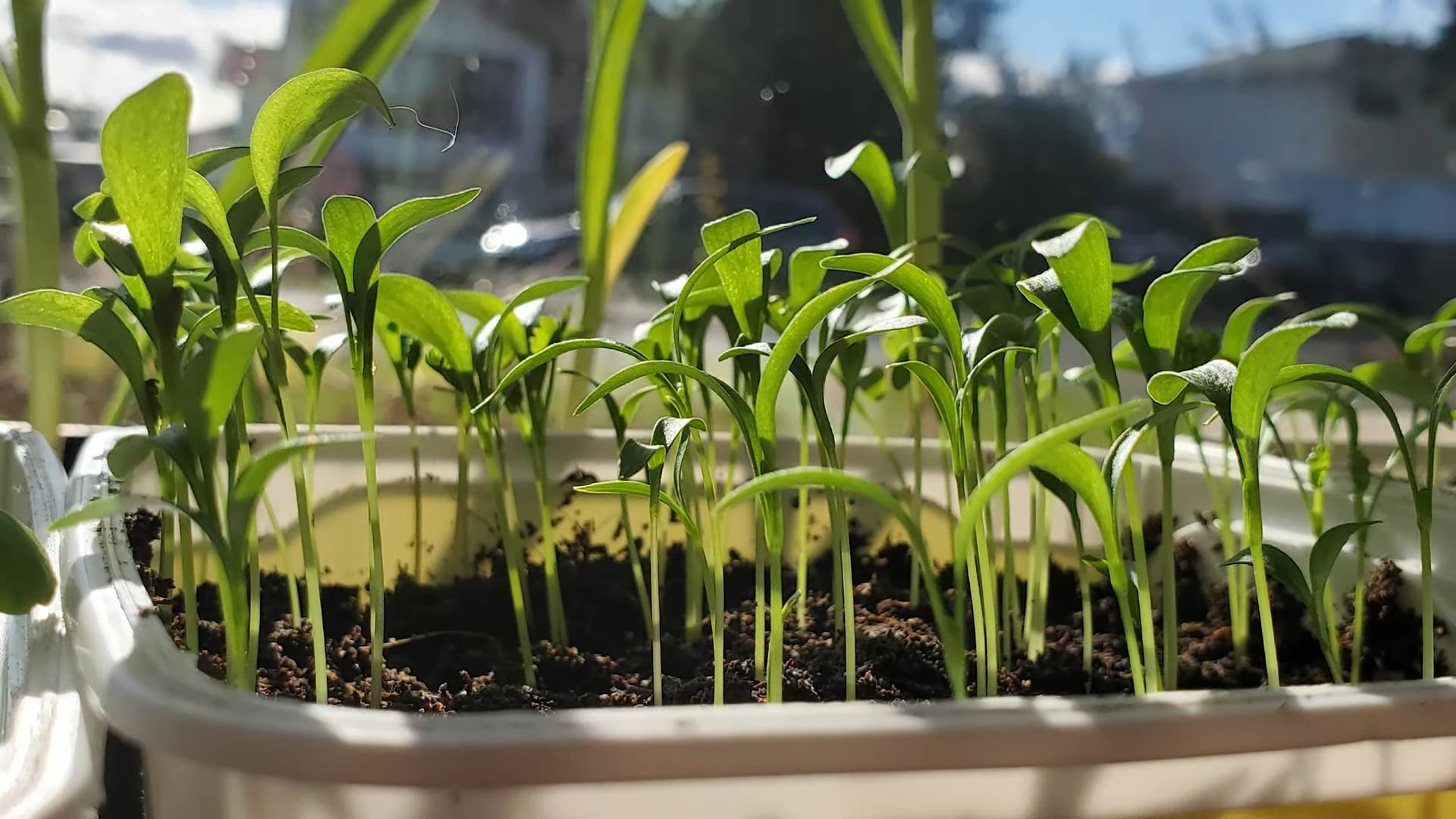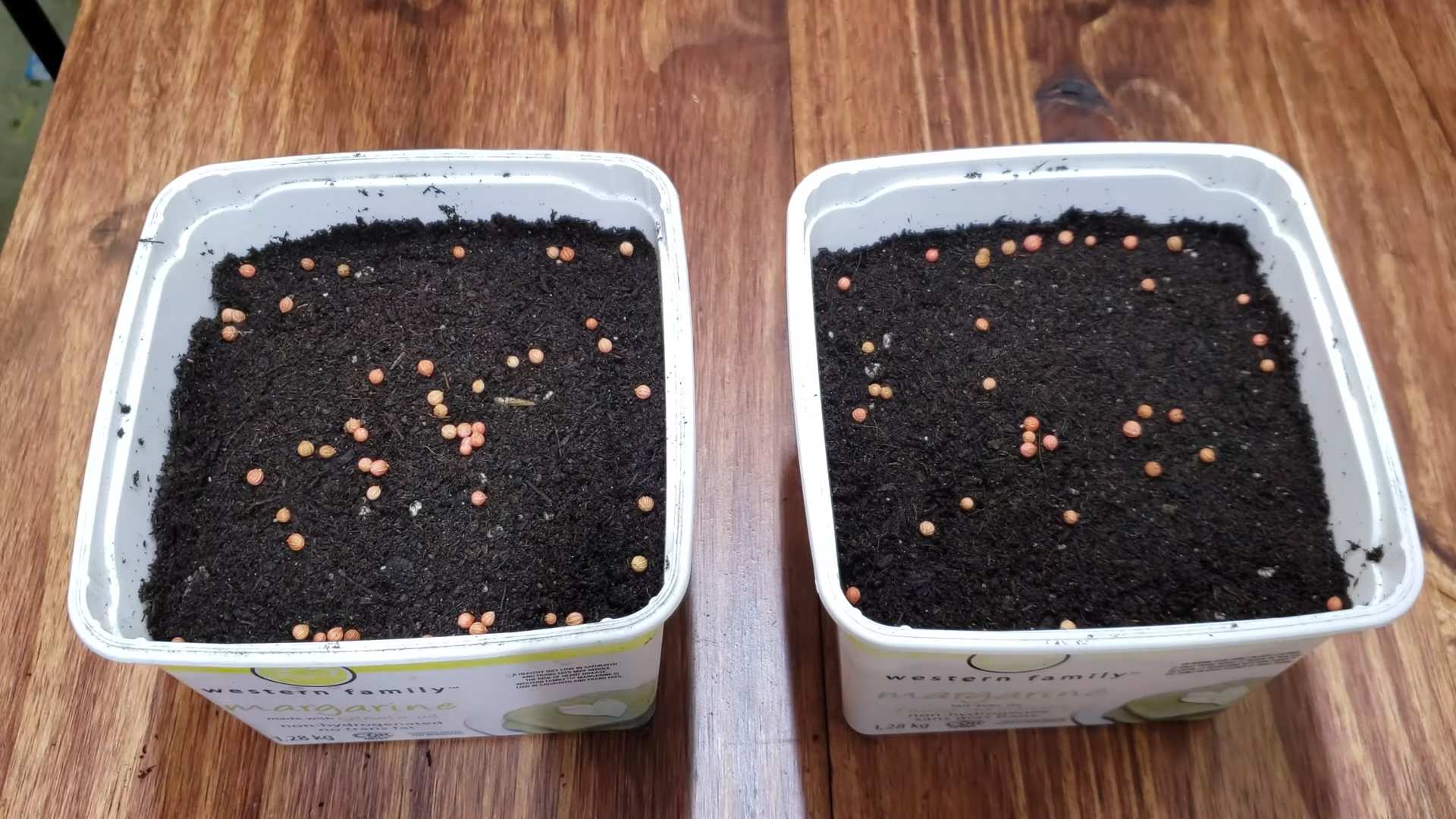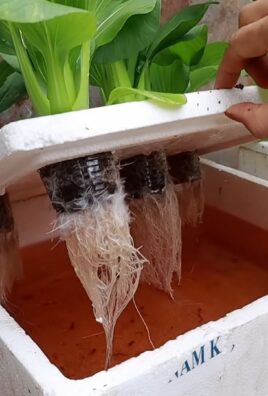Grow Cilantro Indoors? Absolutely! Imagine fresh, vibrant cilantro always at your fingertips, ready to elevate your tacos, brighten your salads, or add that perfect zing to your homemade salsa. No more sad, wilted bunches from the grocery store! For centuries, cilantro has been a culinary staple, tracing its roots back to ancient Egypt, where it was even found in tombs! Its bright, citrusy flavor has graced tables across the globe, and now, you can bring that freshness directly into your home.
But let’s be honest, growing herbs can sometimes feel like a daunting task. Maybe you’ve tried before and ended up with leggy, sad-looking plants. Or perhaps you’re just intimidated by the thought of starting a garden. That’s where these simple, yet effective, DIY tricks come in! I’m here to show you that growing cilantro indoors is easier than you think. With a few clever hacks and a little bit of know-how, you can have a thriving cilantro patch right on your windowsill.
This article is packed with easy-to-follow instructions and insider tips to help you successfully grow cilantro indoors, regardless of your experience level. Say goodbye to expensive store-bought herbs and hello to a constant supply of fresh, flavorful cilantro. Let’s get started!

Grow Your Own Cilantro Indoors: A Beginner’s Guide
Hey there, fellow plant enthusiasts! Are you tired of buying cilantro at the grocery store, only to have it wilt away in your fridge before you can even use half of it? I totally get it! That’s why I decided to take matters into my own hands and grow my own cilantro indoors. And guess what? It’s way easier than you might think! This guide will walk you through everything you need to know to have a thriving cilantro patch right in your kitchen.
What You’ll Need
Before we dive into the nitty-gritty, let’s gather our supplies. Here’s a checklist of everything you’ll need to successfully grow cilantro indoors:
* **Cilantro Seeds:** You can find these at most garden centers or online. Make sure you’re getting cilantro seeds and not coriander seeds (they come from the same plant, but coriander is the dried seed, and we want to start fresh!).
* **Potting Mix:** Use a well-draining potting mix specifically formulated for containers. Avoid using garden soil, as it can compact and hinder drainage.
* **Container:** Choose a pot that’s at least 6 inches deep and wide. Cilantro has a taproot, so it needs room to grow downwards. Make sure your pot has drainage holes!
* **Grow Lights (Optional but Recommended):** While cilantro can grow indoors with natural light, it often benefits from supplemental grow lights, especially during the winter months or in areas with limited sunlight.
* **Watering Can or Spray Bottle:** For gentle watering.
* **Small Shovel or Trowel:** For planting the seeds.
* **Seed Starting Tray (Optional):** If you prefer to start your seeds indoors before transplanting.
* **Fertilizer (Optional):** A balanced liquid fertilizer can help boost growth, but it’s not essential.
Step-by-Step Planting Guide
Okay, now that we have everything we need, let’s get our hands dirty! Here’s a step-by-step guide to planting your cilantro seeds:
1. **Prepare Your Pot:** Fill your chosen container with potting mix, leaving about an inch of space at the top. Gently pat down the soil to remove any large air pockets.
2. **Sow the Seeds:** Cilantro seeds have a hard outer shell, so to improve germination, you can lightly crush them before planting. I usually do this by gently rolling them between two plates or using a mortar and pestle. Don’t grind them into powder, just crack them open a bit.
* **Broadcasting:** You can sprinkle the seeds evenly over the surface of the soil. Aim for about 5-10 seeds per square inch.
* **Individual Planting:** Alternatively, you can plant the seeds individually, spacing them about 1-2 inches apart.
3. **Cover the Seeds:** Lightly cover the seeds with about ¼ inch of potting mix.
4. **Water Gently:** Use a watering can or spray bottle to gently moisten the soil. Avoid overwatering, as this can cause the seeds to rot. The soil should be damp but not soggy.
5. **Provide Light and Warmth:** Place your pot in a warm location with plenty of sunlight. A south-facing window is ideal. If you’re using grow lights, position them a few inches above the soil surface.
6. **Maintain Moisture:** Keep the soil consistently moist but not waterlogged. Check the soil moisture daily and water as needed.
7. **Germination:** Cilantro seeds typically germinate within 7-10 days. Be patient!
Caring for Your Cilantro Plants
Once your cilantro seedlings have emerged, it’s time to focus on providing them with the care they need to thrive.
1. **Light:** Cilantro needs at least 6 hours of sunlight per day. If you’re not getting enough natural light, supplement with grow lights. I’ve found that using a full-spectrum LED grow light for 12-14 hours a day really helps my cilantro plants flourish.
2. **Watering:** Water your cilantro plants regularly, keeping the soil consistently moist but not soggy. Overwatering can lead to root rot, so be sure to let the top inch of soil dry out slightly between waterings. I usually water mine every 2-3 days, but this will depend on the temperature and humidity in your home.
3. **Temperature:** Cilantro prefers cooler temperatures, ideally between 60-75°F (15-24°C). Avoid placing your plants near heat sources, such as radiators or vents.
4. **Fertilizing (Optional):** If you want to give your cilantro plants a boost, you can fertilize them every 2-3 weeks with a balanced liquid fertilizer diluted to half strength. Be careful not to over-fertilize, as this can burn the roots.
5. **Thinning:** Once your seedlings are a few inches tall, you may need to thin them out to prevent overcrowding. Remove the weaker seedlings, leaving the strongest ones spaced about 2-3 inches apart.
6. **Pinching:** To encourage bushier growth, pinch off the top leaves of your cilantro plants when they reach about 4-6 inches tall. This will encourage the plant to produce more side shoots, resulting in a fuller, more productive plant.
Harvesting Your Cilantro
The best part about growing your own cilantro is, of course, harvesting it! You can start harvesting your cilantro leaves when the plants are about 6-8 inches tall.
1. **Harvesting Technique:** Use scissors or pruning shears to cut the stems about an inch above the soil surface. Avoid pulling the leaves off, as this can damage the plant.
2. **Harvesting Frequency:** Harvest your cilantro regularly to encourage continued growth. The more you harvest, the more the plant will produce.
3. **Bolting:** Cilantro is prone to bolting, which means it will start to produce flowers and seeds. Bolting is triggered by hot weather and long days. Once cilantro bolts, the leaves will become bitter. To prevent bolting, keep your plants cool and well-watered. You can also pinch off any flower buds that appear.
4. **Succession Planting:** To ensure a continuous supply of cilantro, sow new seeds every 2-3 weeks. This is called succession planting.
Troubleshooting
Even with the best care, you may encounter some challenges when growing cilantro indoors. Here are a few common problems and how to solve them:
* **Yellowing Leaves:** This can be caused by overwatering, underwatering, or nutrient deficiencies. Check the soil moisture and adjust your watering accordingly. If you suspect a nutrient deficiency, fertilize your plants with a balanced liquid fertilizer.
* **Leggy Growth:** This is usually caused by insufficient light. Move your plants to a brighter location or supplement with grow lights.
* **Pests:** Cilantro can be susceptible to pests such as aphids and spider mites. Inspect your plants regularly and treat any infestations promptly with insecticidal soap or neem oil.
* **Root Rot:** This is caused by overwatering and poor drainage. Make sure your pot has drainage holes and avoid overwatering. If you suspect root rot, repot your plant in fresh potting mix.
Extending the Harvest
Cilantro is a cool-season herb, and it tends to bolt (go to seed) quickly in hot weather. Here are a few tips to extend your cilantro harvest:
* **Choose Bolt-Resistant Varieties:** Some cilantro varieties are more resistant to bolting than others. Look for varieties like ‘Slow Bolt’ or ‘Santo’.
* **Provide Shade:** During the hottest part of the day, provide your cilantro plants with some shade. You can do this by moving them to a cooler location or using a shade cloth.
* **Water Regularly:** Keep your cilantro plants well-watered, especially during hot weather.
* **Pinch Off Flower Buds:** As soon as you see any flower buds appearing, pinch them off. This will help to prevent the plant from bolting.
* **Succession Planting:** As mentioned earlier, sow new seeds every 2-3 weeks to ensure a continuous supply of cilantro.
Enjoy Your Homegrown Cilantro!
And there you have it! With a little bit of care and attention, you can easily grow your own cilantro indoors. Imagine the satisfaction of snipping fresh cilantro leaves right from your kitchen counter to add to your favorite dishes. It’s a game-changer, I promise! Happy gardening!

Conclusion
So, there you have it! Growing cilantro indoors is not only achievable, but it’s also a rewarding experience that brings fresh, vibrant flavor right to your fingertips. Forget those sad, wilted bunches from the grocery store – imagine the satisfaction of snipping off exactly the amount of fresh cilantro you need, whenever you need it. This DIY trick is a must-try for anyone who loves to cook with fresh herbs, especially if you live in an area with a short growing season or limited outdoor space.
Why is this a must-try? Because it’s incredibly convenient, cost-effective, and allows you to control the growing environment, ensuring a consistent supply of this beloved herb. Think about it: no more last-minute trips to the store, no more wasted cilantro going bad in the fridge. Just fresh, fragrant cilantro ready to elevate your tacos, salsas, and curries.
But the fun doesn’t stop there! Feel free to experiment with different varieties of cilantro. Some are known for their slow-bolting tendencies, making them ideal for indoor growing. Consider trying ‘Slow Bolt’ or ‘Santo’ cilantro for a longer harvest. You can also play around with different types of containers. While a standard pot works perfectly well, you might find that a self-watering container helps to maintain consistent moisture levels, especially if you tend to forget to water your plants. Another variation to consider is companion planting. Cilantro thrives alongside other herbs like basil and parsley, so why not create a mini indoor herb garden?
Don’t be intimidated by the thought of growing your own herbs. This method for growing cilantro indoors is surprisingly simple, even for beginners. With just a few basic supplies and a little bit of attention, you’ll be enjoying fresh cilantro in no time.
We truly believe that this DIY project will transform your cooking and bring a touch of green into your home. So, grab your seeds, potting mix, and a sunny spot, and get ready to embark on your indoor cilantro-growing adventure!
We’re confident that you’ll be amazed at how easy and rewarding it is to grow your own cilantro indoors. But more importantly, we want to hear about your experience! Share your tips, tricks, and photos with us in the comments below. Let’s create a community of indoor cilantro growers and learn from each other. What challenges did you face? What successes did you celebrate? We’re eager to hear your stories and help you troubleshoot any issues you might encounter. Happy growing!
Frequently Asked Questions (FAQ)
What is the best time of year to start growing cilantro indoors?
The beauty of growing cilantro indoors is that you can do it year-round! Unlike outdoor gardening, you’re not limited by the seasons. As long as you can provide adequate light and a stable temperature, you can start growing cilantro indoors any time of the year. However, if you’re starting from seed, keep in mind that cilantro prefers cooler temperatures for germination. So, if your home is particularly warm, you might want to consider starting your seeds in a slightly cooler location, like a basement or garage, until they sprout.
How much sunlight does indoor cilantro need?
Cilantro needs at least 6-8 hours of sunlight per day to thrive. A south-facing window is ideal, but an east- or west-facing window can also work. If you don’t have access to enough natural light, you can supplement with a grow light. Fluorescent or LED grow lights are both good options. Position the light a few inches above the plants and keep it on for 12-14 hours per day. Insufficient light will result in leggy, weak plants with poor flavor.
What kind of soil should I use for growing cilantro indoors?
Use a well-draining potting mix. Avoid using garden soil, as it can be too heavy and compact, which can lead to root rot. A good potting mix will retain moisture but also allow excess water to drain away easily. You can also add perlite or vermiculite to your potting mix to improve drainage.
How often should I water my indoor cilantro?
Water your cilantro when the top inch of soil feels dry to the touch. Be careful not to overwater, as this can also lead to root rot. Water thoroughly until water drains out of the bottom of the pot. Empty the saucer underneath the pot to prevent the plant from sitting in water. During the warmer months, you may need to water more frequently than during the cooler months.
Why is my cilantro bolting (going to seed) so quickly?
Bolting is a common problem with cilantro, especially in warm weather. Cilantro is a cool-season herb, and it tends to bolt when temperatures rise. To prevent bolting, try to keep your cilantro in a cool location (around 60-70°F). You can also try growing bolt-resistant varieties of cilantro, such as ‘Slow Bolt’ or ‘Santo’. Regularly harvesting the leaves can also help to delay bolting. Once your cilantro starts to bolt, the leaves will become bitter. However, you can still harvest the seeds (coriander) for use in cooking.
How do I harvest cilantro leaves?
Harvest cilantro leaves by snipping them off with scissors or pinching them off with your fingers. Start harvesting when the plants are about 6 inches tall. Harvest the outer leaves first, leaving the inner leaves to continue growing. Regular harvesting will encourage the plant to produce more leaves.
Can I grow cilantro from cuttings?
While it’s more common to grow cilantro from seed, you can also try propagating it from cuttings. Take a cutting that is about 4-6 inches long and remove the lower leaves. Place the cutting in a glass of water and wait for roots to develop. Once the roots are about an inch long, you can transplant the cutting into a pot of soil.
My cilantro is growing, but the leaves are very small and pale. What could be the problem?
Small, pale leaves can indicate a few different issues. First, make sure your cilantro is getting enough light. Insufficient light is a common cause of weak growth. Second, check the nutrient levels in your soil. Cilantro needs adequate nutrients to thrive. You can fertilize your cilantro with a balanced liquid fertilizer every few weeks. Finally, make sure your cilantro is not overcrowded. If you have too many plants in one pot, they may be competing for resources. Thin out the plants if necessary.
Can I grow cilantro in a hydroponic system?
Yes, cilantro can be successfully grown in a hydroponic system. Hydroponics allows you to control the nutrient levels and growing environment, which can lead to faster growth and higher yields. There are many different types of hydroponic systems you can use, such as deep water culture, nutrient film technique, and ebb and flow.
What are some common pests and diseases that affect indoor cilantro?
Indoor cilantro is generally less susceptible to pests and diseases than outdoor cilantro. However, some common problems include aphids, spider mites, and powdery mildew. Aphids and spider mites can be controlled with insecticidal soap or neem oil. Powdery mildew can be prevented by providing good air circulation and avoiding overwatering.
How long will my indoor cilantro plant last?
With proper care, your indoor cilantro plant can last for several months. However, keep in mind that cilantro is an annual herb, so it will eventually bolt and die. To extend the life of your plant, try to prevent bolting by keeping it in a cool location and regularly harvesting the leaves. You can also succession plant cilantro by starting new seeds every few weeks to ensure a continuous supply of fresh herbs.




Leave a Comment